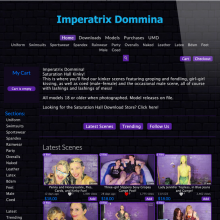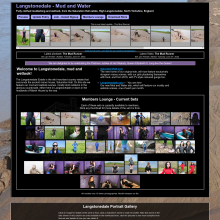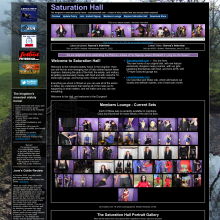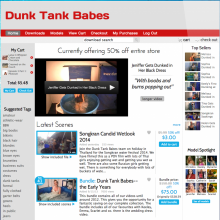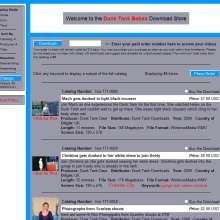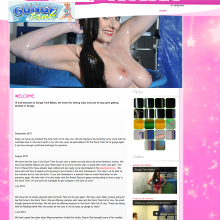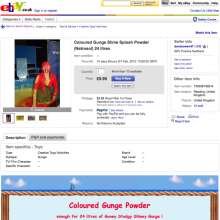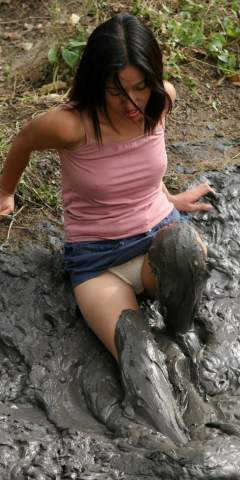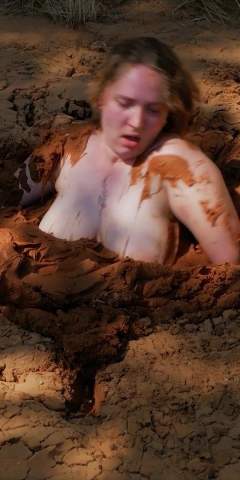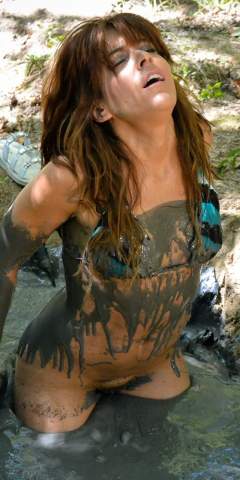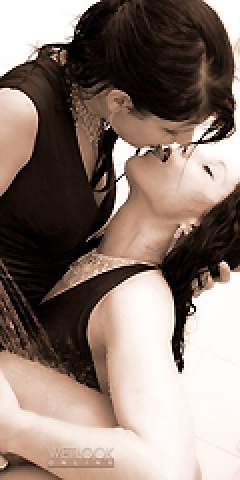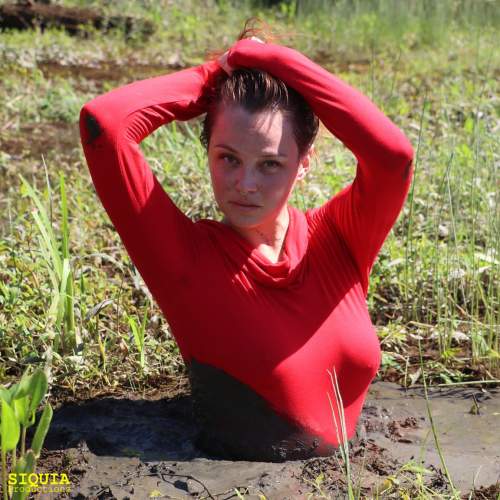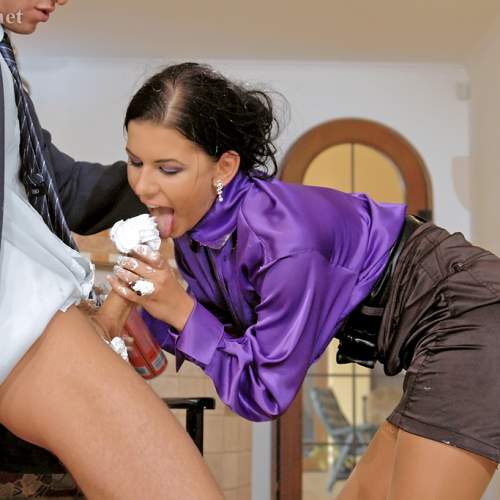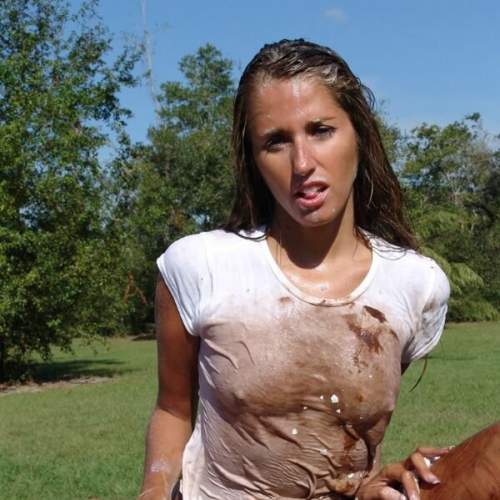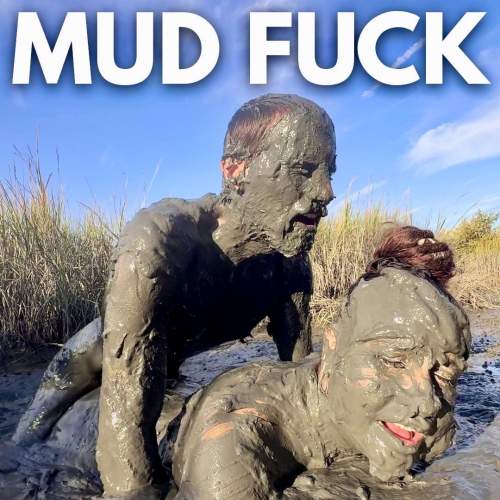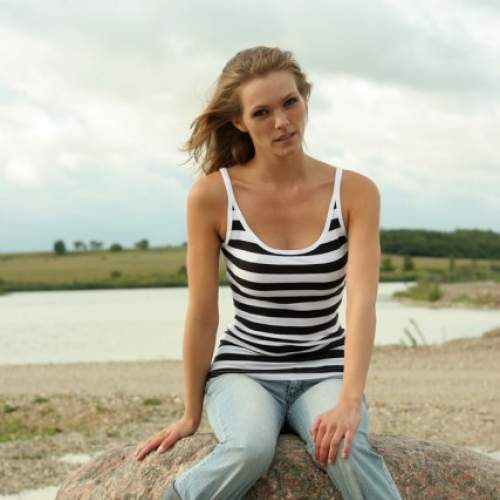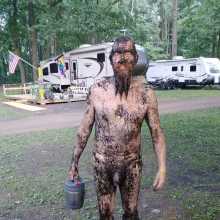|
|
|||
| forums: groups: | |||
|
"Adding Colour to Gunge (Natrosol)"
Hey guys
Just want to see how you guys mix your own colours in to gunge.
I'm buying plain Natrosol.
I want to make sure the colour I add doesn't stain my skin or hair
Thanks Guys xo
Just want to see how you guys mix your own colours in to gunge.
I'm buying plain Natrosol.
I want to make sure the colour I add doesn't stain my skin or hair
Thanks Guys xo
Saturation Hall, Langstonedale
Lord of the Pies
I gather the colour in commercial gunge is kid-safe powder paint, which is designed not to permanently stain, and is harmless if ingested, given how kids are liable to end up licking it. We use the Messy Supplies stuff, and have had no problems with skin or hair staining.
The thing that stains skin the worst is tomato soup - we've had models go home from savoury shoots looking distinctly orange before now.
The thing that stains skin the worst is tomato soup - we've had models go home from savoury shoots looking distinctly orange before now.

Saturation Hall - Forth! The Gungemaidens!
DungeonMasterOne said: I gather the colour in commercial gunge is kid-safe powder paint, which is designed not to permanently stain, and is harmless if ingested, given how kids are liable to end up licking it. We use the Messy Supplies stuff, and have had no problems with skin or hair staining.
The thing that stains skin the worst is tomato soup - we've had models go home from savoury shoots looking distinctly orange before now.
The thing that stains skin the worst is tomato soup - we've had models go home from savoury shoots looking distinctly orange before now.

Thanks hun I'll look into it. Yeah I would get messy supplies but it takes a while to get to Australia
I'll just add a couple notes about gunge colouring with powder paints.
Uncoloured gunge is translucent by default - if you just add the colour you want you will get a translucent version of that colour. ie if you just add green then you'll get a translucent green like a wine bottle.
If you want an opaque version of a colour then you will also need to add a little white powder paint as well. Even if you want an opaque black you'll need to add a spoon of white powder paint to 2-3 spoons of black.
As such if you want most of your gunge to be opaque and not partially transparent then buy a higher quantity of white as you'll need to add it to each bucket regardless of colour.
If you want to get brighter versions of some colours it is worth trying out UV/Neon powder paints as well as regular powder paint colours (if you want a comparison between them let me know and I'll link to some old images from my crossdressmess days of each in action).
Some colours work better in one than the other - for instance if you want Hot Pink a neon/uv one is best whilst colours like red or brown are better done with regular powder paint - and my best results with purple actually came from mixing a neon pink with a regular blue but anyway colours will vary by brand and personal preferences may vary.
When it came to mixing the paint with the Natrasol what I used to do is measure out the amount of Natrasol I needed for a specific thickness, dump the Natrasol into an empty bucket, toss in a spoon of white powder paint, toss in a couple spoons of colour. Whoosh all the powder together into a uniform colour shaking the bucket in a circular motion. Take bucket filled with warm water and pour the water into the bucket of powder and begin stirring.
I was however using HR250 grade of Natrasol which has been treated to slow down the powder hydrating into gunge to take about 5-10 minutes to mix so it was possible to pour the water into a bucket of powder. If you're using a grade of Natrasol that doesn't have an R in the grade name then it may be that you'll need to sprinkle the mixed powder into a bucket of water that is being stirred to avoid clumping.
Uncoloured gunge is translucent by default - if you just add the colour you want you will get a translucent version of that colour. ie if you just add green then you'll get a translucent green like a wine bottle.
If you want an opaque version of a colour then you will also need to add a little white powder paint as well. Even if you want an opaque black you'll need to add a spoon of white powder paint to 2-3 spoons of black.
As such if you want most of your gunge to be opaque and not partially transparent then buy a higher quantity of white as you'll need to add it to each bucket regardless of colour.
If you want to get brighter versions of some colours it is worth trying out UV/Neon powder paints as well as regular powder paint colours (if you want a comparison between them let me know and I'll link to some old images from my crossdressmess days of each in action).
Some colours work better in one than the other - for instance if you want Hot Pink a neon/uv one is best whilst colours like red or brown are better done with regular powder paint - and my best results with purple actually came from mixing a neon pink with a regular blue but anyway colours will vary by brand and personal preferences may vary.
When it came to mixing the paint with the Natrasol what I used to do is measure out the amount of Natrasol I needed for a specific thickness, dump the Natrasol into an empty bucket, toss in a spoon of white powder paint, toss in a couple spoons of colour. Whoosh all the powder together into a uniform colour shaking the bucket in a circular motion. Take bucket filled with warm water and pour the water into the bucket of powder and begin stirring.
I was however using HR250 grade of Natrasol which has been treated to slow down the powder hydrating into gunge to take about 5-10 minutes to mix so it was possible to pour the water into a bucket of powder. If you're using a grade of Natrasol that doesn't have an R in the grade name then it may be that you'll need to sprinkle the mixed powder into a bucket of water that is being stirred to avoid clumping.
I've typically always used food coloring for color & talcum powder for opacity. As for actually purchasing gunge in Australia I have discovered local cosmetic suppliers that stock thickening agents. International shipping costs can be exorbitant, so these were a good alternative. I can PM a supplier if you're interested.
Your parents were wrong. Play with your food.
theStickyTrickster said: I'll just add a couple notes about gunge colouring with powder paints.
Uncoloured gunge is translucent by default - if you just add the colour you want you will get a translucent version of that colour. ie if you just add green then you'll get a translucent green like a wine bottle.
If you want an opaque version of a colour then you will also need to add a little white powder paint as well. Even if you want an opaque black you'll need to add a spoon of white powder paint to 2-3 spoons of black.
As such if you want most of your gunge to be opaque and not partially transparent then buy a higher quantity of white as you'll need to add it to each bucket regardless of colour.
If you want to get brighter versions of some colours it is worth trying out UV/Neon powder paints as well as regular powder paint colours (if you want a comparison between them let me know and I'll link to some old images from my crossdressmess days of each in action).
Some colours work better in one than the other - for instance if you want Hot Pink a neon/uv one is best whilst colours like red or brown are better done with regular powder paint - and my best results with purple actually came from mixing a neon pink with a regular blue but anyway colours will vary by brand and personal preferences may vary.
When it came to mixing the paint with the Natrasol what I used to do is measure out the amount of Natrasol I needed for a specific thickness, dump the Natrasol into an empty bucket, toss in a spoon of white powder paint, toss in a couple spoons of colour. Whoosh all the powder together into a uniform colour shaking the bucket in a circular motion. Take bucket filled with warm water and pour the water into the bucket of powder and begin stirring.
I was however using HR250 grade of Natrasol which has been treated to slow down the powder hydrating into gunge to take about 5-10 minutes to mix so it was possible to pour the water into a bucket of powder. If you're using a grade of Natrasol that doesn't have an R in the grade name then it may be that you'll need to sprinkle the mixed powder into a bucket of water that is being stirred to avoid clumping.
Uncoloured gunge is translucent by default - if you just add the colour you want you will get a translucent version of that colour. ie if you just add green then you'll get a translucent green like a wine bottle.
If you want an opaque version of a colour then you will also need to add a little white powder paint as well. Even if you want an opaque black you'll need to add a spoon of white powder paint to 2-3 spoons of black.
As such if you want most of your gunge to be opaque and not partially transparent then buy a higher quantity of white as you'll need to add it to each bucket regardless of colour.
If you want to get brighter versions of some colours it is worth trying out UV/Neon powder paints as well as regular powder paint colours (if you want a comparison between them let me know and I'll link to some old images from my crossdressmess days of each in action).
Some colours work better in one than the other - for instance if you want Hot Pink a neon/uv one is best whilst colours like red or brown are better done with regular powder paint - and my best results with purple actually came from mixing a neon pink with a regular blue but anyway colours will vary by brand and personal preferences may vary.
When it came to mixing the paint with the Natrasol what I used to do is measure out the amount of Natrasol I needed for a specific thickness, dump the Natrasol into an empty bucket, toss in a spoon of white powder paint, toss in a couple spoons of colour. Whoosh all the powder together into a uniform colour shaking the bucket in a circular motion. Take bucket filled with warm water and pour the water into the bucket of powder and begin stirring.
I was however using HR250 grade of Natrasol which has been treated to slow down the powder hydrating into gunge to take about 5-10 minutes to mix so it was possible to pour the water into a bucket of powder. If you're using a grade of Natrasol that doesn't have an R in the grade name then it may be that you'll need to sprinkle the mixed powder into a bucket of water that is being stirred to avoid clumping.
Oh wow this helps a lot thanks. So any paint powder is ok?
Viscocity said: I've typically always used food coloring for color & talcum powder for opacity. As for actually purchasing gunge in Australia I have discovered local cosmetic suppliers that stock thickening agents. International shipping costs can be exorbitant, so these were a good alternative. I can PM a supplier if you're interested.
Yes please this would be great thanks
I've done some googling also and found this.
https://www.google.com.au/amp/s/www.instructables.com/Gunge/%3famp_page=true
https://www.google.com.au/amp/s/www.instructables.com/Gunge/%3famp_page=true
theStickyTrickster said: I'll just add a couple notes about gunge colouring with powder paints.
Uncoloured gunge is translucent by default - if you just add the colour you want you will get a translucent version of that colour. ie if you just add green then you'll get a translucent green like a wine bottle.
If you want an opaque version of a colour then you will also need to add a little white powder paint as well. Even if you want an opaque black you'll need to add a spoon of white powder paint to 2-3 spoons of black.
As such if you want most of your gunge to be opaque and not partially transparent then buy a higher quantity of white as you'll need to add it to each bucket regardless of colour.
If you want to get brighter versions of some colours it is worth trying out UV/Neon powder paints as well as regular powder paint colours (if you want a comparison between them let me know and I'll link to some old images from my crossdressmess days of each in action).
Some colours work better in one than the other - for instance if you want Hot Pink a neon/uv one is best whilst colours like red or brown are better done with regular powder paint - and my best results with purple actually came from mixing a neon pink with a regular blue but anyway colours will vary by brand and personal preferences may vary.
When it came to mixing the paint with the Natrasol what I used to do is measure out the amount of Natrasol I needed for a specific thickness, dump the Natrasol into an empty bucket, toss in a spoon of white powder paint, toss in a couple spoons of colour. Whoosh all the powder together into a uniform colour shaking the bucket in a circular motion. Take bucket filled with warm water and pour the water into the bucket of powder and begin stirring.
I was however using HR250 grade of Natrasol which has been treated to slow down the powder hydrating into gunge to take about 5-10 minutes to mix so it was possible to pour the water into a bucket of powder. If you're using a grade of Natrasol that doesn't have an R in the grade name then it may be that you'll need to sprinkle the mixed powder into a bucket of water that is being stirred to avoid clumping.
Uncoloured gunge is translucent by default - if you just add the colour you want you will get a translucent version of that colour. ie if you just add green then you'll get a translucent green like a wine bottle.
If you want an opaque version of a colour then you will also need to add a little white powder paint as well. Even if you want an opaque black you'll need to add a spoon of white powder paint to 2-3 spoons of black.
As such if you want most of your gunge to be opaque and not partially transparent then buy a higher quantity of white as you'll need to add it to each bucket regardless of colour.
If you want to get brighter versions of some colours it is worth trying out UV/Neon powder paints as well as regular powder paint colours (if you want a comparison between them let me know and I'll link to some old images from my crossdressmess days of each in action).
Some colours work better in one than the other - for instance if you want Hot Pink a neon/uv one is best whilst colours like red or brown are better done with regular powder paint - and my best results with purple actually came from mixing a neon pink with a regular blue but anyway colours will vary by brand and personal preferences may vary.
When it came to mixing the paint with the Natrasol what I used to do is measure out the amount of Natrasol I needed for a specific thickness, dump the Natrasol into an empty bucket, toss in a spoon of white powder paint, toss in a couple spoons of colour. Whoosh all the powder together into a uniform colour shaking the bucket in a circular motion. Take bucket filled with warm water and pour the water into the bucket of powder and begin stirring.
I was however using HR250 grade of Natrasol which has been treated to slow down the powder hydrating into gunge to take about 5-10 minutes to mix so it was possible to pour the water into a bucket of powder. If you're using a grade of Natrasol that doesn't have an R in the grade name then it may be that you'll need to sprinkle the mixed powder into a bucket of water that is being stirred to avoid clumping.
Adding white might help a little but in essence the white just gives a white transparent which you add the colour to giving a dilution to that colour. We tried many many different recipes and types of Gunge over the years we were supplying Gunge. Although Natrosol is easy to mix it's not the best if you want a thick colour. Natrosol by its nature will give a translucent Gunge. We did use to add an additive to give a foamy deluxe Gunge which reduced how translucent it was which worked well.
As stickytrickster says the grade you use is critical to how it mixes and clumping etc. we tried around 40 to 50 different grades for HEC, Mythl Cellulose as well as many other types of thickeners. Natrosol is the go to name because that's what the BBC used but it's not the best by a long way.
Just going back to colouring, powder paint is good as a commercial producer to send out but for some of our shoots we used liquid poster paint which was far better. Both are safe to use but it's likely you will get some staining with both.
www.gungetankbabes.com
Kid-safe poster paint is your best bet- either as a dry powder or the ready mixed tempura paints.
This can still leave stains if left to dry on- things like bathtub, tiles, shower curtain, clothes etc...
If you have very pale skin/hair this still has the potential to stain.
You may be tempted (as many of us have) to use food colouring. This is significantly more likely to stain your skin- depending on the colour used and active ingredient, how much you add, and how pale your skin is.
It's "safe" to go this route- always test on a discreet patch of skin first.
Avoid household/metal/gloss paints- as the pigments/solvents are much more aggressive (skin irritation), very likely to stain, and sometimes toxic.
This can still leave stains if left to dry on- things like bathtub, tiles, shower curtain, clothes etc...
If you have very pale skin/hair this still has the potential to stain.
You may be tempted (as many of us have) to use food colouring. This is significantly more likely to stain your skin- depending on the colour used and active ingredient, how much you add, and how pale your skin is.
It's "safe" to go this route- always test on a discreet patch of skin first.
Avoid household/metal/gloss paints- as the pigments/solvents are much more aggressive (skin irritation), very likely to stain, and sometimes toxic.
I guess I'm different. I like it white or clear, - but hey ho!
GungeTankBabes said:
Adding white might help a little but in essence the white just gives a white transparent which you add the colour to giving a dilution to that colour. We tried many many different recipes and types of Gunge over the years we were supplying Gunge. Although Natrosol is easy to mix it's not the best if you want a thick colour. Natrosol by its nature will give a translucent Gunge. We did use to add an additive to give a foamy deluxe Gunge which reduced how translucent it was which worked well.
As stickytrickster says the grade you use is critical to how it mixes and clumping etc. we tried around 40 to 50 different grades for HEC, Mythl Cellulose as well as many other types of thickeners. Natrosol is the go to name because that's what the BBC used but it's not the best by a long way.
Just going back to colouring, powder paint is good as a commercial producer to send out but for some of our shoots we used liquid poster paint which was far better. Both are safe to use but it's likely you will get some staining with both.
theStickyTrickster said: I'll just add a couple notes about gunge colouring with powder paints.
Uncoloured gunge is translucent by default - if you just add the colour you want you will get a translucent version of that colour. ie if you just add green then you'll get a translucent green like a wine bottle.
If you want an opaque version of a colour then you will also need to add a little white powder paint as well. Even if you want an opaque black you'll need to add a spoon of white powder paint to 2-3 spoons of black.
As such if you want most of your gunge to be opaque and not partially transparent then buy a higher quantity of white as you'll need to add it to each bucket regardless of colour.
If you want to get brighter versions of some colours it is worth trying out UV/Neon powder paints as well as regular powder paint colours (if you want a comparison between them let me know and I'll link to some old images from my crossdressmess days of each in action).
Some colours work better in one than the other - for instance if you want Hot Pink a neon/uv one is best whilst colours like red or brown are better done with regular powder paint - and my best results with purple actually came from mixing a neon pink with a regular blue but anyway colours will vary by brand and personal preferences may vary.
When it came to mixing the paint with the Natrasol what I used to do is measure out the amount of Natrasol I needed for a specific thickness, dump the Natrasol into an empty bucket, toss in a spoon of white powder paint, toss in a couple spoons of colour. Whoosh all the powder together into a uniform colour shaking the bucket in a circular motion. Take bucket filled with warm water and pour the water into the bucket of powder and begin stirring.
I was however using HR250 grade of Natrasol which has been treated to slow down the powder hydrating into gunge to take about 5-10 minutes to mix so it was possible to pour the water into a bucket of powder. If you're using a grade of Natrasol that doesn't have an R in the grade name then it may be that you'll need to sprinkle the mixed powder into a bucket of water that is being stirred to avoid clumping.
Uncoloured gunge is translucent by default - if you just add the colour you want you will get a translucent version of that colour. ie if you just add green then you'll get a translucent green like a wine bottle.
If you want an opaque version of a colour then you will also need to add a little white powder paint as well. Even if you want an opaque black you'll need to add a spoon of white powder paint to 2-3 spoons of black.
As such if you want most of your gunge to be opaque and not partially transparent then buy a higher quantity of white as you'll need to add it to each bucket regardless of colour.
If you want to get brighter versions of some colours it is worth trying out UV/Neon powder paints as well as regular powder paint colours (if you want a comparison between them let me know and I'll link to some old images from my crossdressmess days of each in action).
Some colours work better in one than the other - for instance if you want Hot Pink a neon/uv one is best whilst colours like red or brown are better done with regular powder paint - and my best results with purple actually came from mixing a neon pink with a regular blue but anyway colours will vary by brand and personal preferences may vary.
When it came to mixing the paint with the Natrasol what I used to do is measure out the amount of Natrasol I needed for a specific thickness, dump the Natrasol into an empty bucket, toss in a spoon of white powder paint, toss in a couple spoons of colour. Whoosh all the powder together into a uniform colour shaking the bucket in a circular motion. Take bucket filled with warm water and pour the water into the bucket of powder and begin stirring.
I was however using HR250 grade of Natrasol which has been treated to slow down the powder hydrating into gunge to take about 5-10 minutes to mix so it was possible to pour the water into a bucket of powder. If you're using a grade of Natrasol that doesn't have an R in the grade name then it may be that you'll need to sprinkle the mixed powder into a bucket of water that is being stirred to avoid clumping.
Adding white might help a little but in essence the white just gives a white transparent which you add the colour to giving a dilution to that colour. We tried many many different recipes and types of Gunge over the years we were supplying Gunge. Although Natrosol is easy to mix it's not the best if you want a thick colour. Natrosol by its nature will give a translucent Gunge. We did use to add an additive to give a foamy deluxe Gunge which reduced how translucent it was which worked well.
As stickytrickster says the grade you use is critical to how it mixes and clumping etc. we tried around 40 to 50 different grades for HEC, Mythl Cellulose as well as many other types of thickeners. Natrosol is the go to name because that's what the BBC used but it's not the best by a long way.
Just going back to colouring, powder paint is good as a commercial producer to send out but for some of our shoots we used liquid poster paint which was far better. Both are safe to use but it's likely you will get some staining with both.
Please do share what is better than Natrosol? You can DM me if you like xo
GungeTankBabes said: Adding white might help a little but in essence the white just gives a white transparent which you add the colour to giving a dilution to that colour.
If you weren't getting opaque gunge upon adding white you were either not adding enough white, the gunge itself was not thick enough or it was improperly mixed in such away that most of the powder was allowed to settle and set into a hard jelly at the bottom of the receptacle leaving too little in the actual gunge solution.
Here is a link to 2 quick collages from two different CDM shoots comparing regular powder paints and one UV/neon powder paints to also illustrate how neither have issues with transparency using white paint https://umd.net/profile/id/110499/section/photos/album/gunge-colour
GungeTankBabes said: We tried many many different recipes and types of Gunge over the years we were supplying Gunge. Although Natrosol is easy to mix it's not the best if you want a thick colour. Natrosol by its nature will give a translucent Gunge.
The colour you get is independent of the thickener you use. For a start each of the celluloses and saccharide based thickeners are semi-transparent when mixed. It makes no difference which is used; there is no scientific basis to claim Natrasol is any worse at being coloured than other celluloses and saccharide based thickeners.
It should also be remembered powder paint is made specifically to turn water, which is more transparent than any of the uncoloured slime solutions, into opaque paint - it isn't simply going to fail to do that because Natrasol has been added.
In very simplified physics. Water is transparent because it allows light within the visible part of the electromagnetic spectrum to pass through it. White appears white because it reflects all wavelengths of visible light. By adding the white paint you reduce the transparency until sufficient white has been added to let no light through and be opaque - and no it is not just becoming paint instead of gunge at the concentrations I'm talking about.
GungeTankBabes said: As stickytrickster says the grade you use is critical to how it mixes and clumping etc. we tried around 40 to 50 different grades for HEC, Mythl Cellulose as well as many other types of thickeners. Natrosol is the go to name because that's what the BBC used but it's not the best by a long way.
Given that your stores focus around a dunk tank I think I should add for clarity that whilst the BBC used Natrasol for the likes of NHP and L&K (which they happened to colour with Helizarin dyes. The now defunct Basic Chemical Company that supplied the BBC with Natrasol during the NHP days though did not recommend Helizarin dyes to non-TV customers as they often permanently stained clothing - I don't recommend them either, just including it for complete accuracy) they instead used Xanthum Gum to make the gunge for GYOB.
The reason for switching to Xanthum for GYOB was that the usual mixing process for Natrasol made no sense for a full dunk vat of gunge as it would need continuously stirring whilst it hydrated for around 10 minutes which was possible on that scale without leading to loads of lumps or large amounts of powder settling at the bottom and forming a big jelly brick. Instead they created a special hose/mincing device that slowly fed Xanthum powder into the water running through the hose to instantly hose out gunge to fill the tank with.
If most of your issues with Natrasol came from trying to fill a dunk tank - especially using any grade treated to slow down the hydration into gunge - then you're just running into the issues the BBC sort to avoid with GYOB in that Natrasol doesn't scale up to Dunk Tank quantities easily. There is probably a good chance most of the Natrasol and powder paint sank to the bottom of the tank and congealed. Xanthum however has other challenges when it comes to mixing it - indeed those challenges being part of the reason the quality of gunge on GYOB was so variable.
When I first experimented with Xanthum 16 years ago I was able to get similar results to Natrasol with it but quickly came to the conclusion what is the point in being able to produce identical results with a whole bunch of different chemicals. Ever since I've used Xanthum in a non-standard way to make deliberately lumpy slimes for whenever I'm doing some form of "designer slime" where I mix certain safe chemicals to get a specific effect (ie stretchy effect with a Natrasol/Poly Ox mix) and so forth.
I won't make any pronouncements of which gunge is better as frankly arguments between the likes of Natrasol and Methyl Cellulose are pointless for if you know what you are doing you can make identical looking buckets of gunge with the same viscosity and colour from each of them (it's not particularly advanced chemistry). And there are so many other possible gunges/slimes that could be made from various mixtures that arguing about which chemical makes the better version of a practically identical substance in both look and feel is just pointless.
I don't have much colouring advice (please do share what works for you in Australia!) however if it's your first rodeo with Natrosol then below should help 
Natrosol is known chemically as Hydroxyethyl Cellulose (also known as HEC). Bonus fact, HEC is the main ingredient of KY Jelly.
Water needs to be warm otherwise it takes an eternity to to thicken. 40C seems to be the minimum but takes a good 10+ minutes to thicken up. 50C will thicken within minutes, but will take ages to cool down to a safe temperature.
50g/4L about is as thick as you will want to mix it and above 30-40g/4L it becomes a bit of a shit to clean up (it less readily dissolves into water).
You will want the powder in the bottom of the bucket then add the water to the bucket as it will help disperse the powder and avoid clumps. Highly recommend mixing it with a paint mixer attachment on a cordless drill.
I recommend mixing it clear the first time as it makes it very easy to know when it has thickened. It'll be opaque before becoming thick and then shortly after thickening up it will become crystal clear. The bottom of my buckets have smiley faces, when the smiley appears, it's gunge time
Then once you get the swing of mixing it you can add colour.
For clean up I like to fill the bottom of the bathtub with about 50mm of water then run my fingers through the gunge, swishing left and right to help dissipate/dilute it.
Until it's broken up/diluted and no longer slippery, DO NOT STAND UP. You **will** eat shit if you try to stand up whilst it's still slippery. It's not like oils and other "slippery" food based gunge where after a bit of pressure from your feet it gets less slippery. This shit will stay slippery as fuck no matter what until you wash it away. I guess that's why they chose it for KY Jelly.
Remember to wipe it off your feet too!
I've coloured mine with Titanium Dioxide, however it has recently been classified as a probable carcinogen, even in solution, so I don't recommend using it.
55g/4L HEC/Water + 6.5g Titanium Dioxide == cum I worked that out trying to workout how little Titanium Dioxide I need to make it opaque.
I worked that out trying to workout how little Titanium Dioxide I need to make it opaque.

Natrosol is known chemically as Hydroxyethyl Cellulose (also known as HEC). Bonus fact, HEC is the main ingredient of KY Jelly.
Water needs to be warm otherwise it takes an eternity to to thicken. 40C seems to be the minimum but takes a good 10+ minutes to thicken up. 50C will thicken within minutes, but will take ages to cool down to a safe temperature.
50g/4L about is as thick as you will want to mix it and above 30-40g/4L it becomes a bit of a shit to clean up (it less readily dissolves into water).
You will want the powder in the bottom of the bucket then add the water to the bucket as it will help disperse the powder and avoid clumps. Highly recommend mixing it with a paint mixer attachment on a cordless drill.
I recommend mixing it clear the first time as it makes it very easy to know when it has thickened. It'll be opaque before becoming thick and then shortly after thickening up it will become crystal clear. The bottom of my buckets have smiley faces, when the smiley appears, it's gunge time

Then once you get the swing of mixing it you can add colour.
For clean up I like to fill the bottom of the bathtub with about 50mm of water then run my fingers through the gunge, swishing left and right to help dissipate/dilute it.
Until it's broken up/diluted and no longer slippery, DO NOT STAND UP. You **will** eat shit if you try to stand up whilst it's still slippery. It's not like oils and other "slippery" food based gunge where after a bit of pressure from your feet it gets less slippery. This shit will stay slippery as fuck no matter what until you wash it away. I guess that's why they chose it for KY Jelly.
Remember to wipe it off your feet too!
I've coloured mine with Titanium Dioxide, however it has recently been classified as a probable carcinogen, even in solution, so I don't recommend using it.
55g/4L HEC/Water + 6.5g Titanium Dioxide == cum
 I worked that out trying to workout how little Titanium Dioxide I need to make it opaque.
I worked that out trying to workout how little Titanium Dioxide I need to make it opaque.asfp9f47 said: I don't have much colouring advice (please do share what works for you in Australia!) however if it's your first rodeo with Natrosol then below should help 
Natrosol is known chemically as Hydroxyethyl Cellulose (also known as HEC). Bonus fact, HEC is the main ingredient of KY Jelly.
Water needs to be warm otherwise it takes an eternity to to thicken. 40C seems to be the minimum but takes a good 10+ minutes to thicken up. 50C will thicken within minutes, but will take ages to cool down to a safe temperature.
50g/4L about is as thick as you will want to mix it and above 30-40g/4L it becomes a bit of a shit to clean up (it less readily dissolves into water).
You will want the powder in the bottom of the bucket then add the water to the bucket as it will help disperse the powder and avoid clumps. Highly recommend mixing it with a paint mixer attachment on a cordless drill.
I recommend mixing it clear the first time as it makes it very easy to know when it has thickened. It'll be opaque before becoming thick and then shortly after thickening up it will become crystal clear. The bottom of my buckets have smiley faces, when the smiley appears, it's gunge time
Then once you get the swing of mixing it you can add colour.
For clean up I like to fill the bottom of the bathtub with about 50mm of water then run my fingers through the gunge, swishing left and right to help dissipate/dilute it.
Until it's broken up/diluted and no longer slippery, DO NOT STAND UP. You **will** eat shit if you try to stand up whilst it's still slippery. It's not like oils and other "slippery" food based gunge where after a bit of pressure from your feet it gets less slippery. This shit will stay slippery as fuck no matter what until you wash it away. I guess that's why they chose it for KY Jelly.
Remember to wipe it off your feet too!
I've coloured mine with Titanium Dioxide, however it has recently been classified as a probable carcinogen, even in solution, so I don't recommend using it.
55g/4L HEC/Water + 6.5g Titanium Dioxide == cum I worked that out trying to workout how little Titanium Dioxide I need to make it opaque.
I worked that out trying to workout how little Titanium Dioxide I need to make it opaque.

Natrosol is known chemically as Hydroxyethyl Cellulose (also known as HEC). Bonus fact, HEC is the main ingredient of KY Jelly.
Water needs to be warm otherwise it takes an eternity to to thicken. 40C seems to be the minimum but takes a good 10+ minutes to thicken up. 50C will thicken within minutes, but will take ages to cool down to a safe temperature.
50g/4L about is as thick as you will want to mix it and above 30-40g/4L it becomes a bit of a shit to clean up (it less readily dissolves into water).
You will want the powder in the bottom of the bucket then add the water to the bucket as it will help disperse the powder and avoid clumps. Highly recommend mixing it with a paint mixer attachment on a cordless drill.
I recommend mixing it clear the first time as it makes it very easy to know when it has thickened. It'll be opaque before becoming thick and then shortly after thickening up it will become crystal clear. The bottom of my buckets have smiley faces, when the smiley appears, it's gunge time

Then once you get the swing of mixing it you can add colour.
For clean up I like to fill the bottom of the bathtub with about 50mm of water then run my fingers through the gunge, swishing left and right to help dissipate/dilute it.
Until it's broken up/diluted and no longer slippery, DO NOT STAND UP. You **will** eat shit if you try to stand up whilst it's still slippery. It's not like oils and other "slippery" food based gunge where after a bit of pressure from your feet it gets less slippery. This shit will stay slippery as fuck no matter what until you wash it away. I guess that's why they chose it for KY Jelly.
Remember to wipe it off your feet too!
I've coloured mine with Titanium Dioxide, however it has recently been classified as a probable carcinogen, even in solution, so I don't recommend using it.
55g/4L HEC/Water + 6.5g Titanium Dioxide == cum
 I worked that out trying to workout how little Titanium Dioxide I need to make it opaque.
I worked that out trying to workout how little Titanium Dioxide I need to make it opaque. I beg to differ but having bought Gunge literally by the ton to sell on and experimented with many types, the opacity of Base thickener makes a huge difference. Natrosol is great to use and easy and can be coloured. As you say, almost any thickener can make a good gunge if mixed correctly. We used and were selling for some years a different brand of HEC, almost the same spec as Natrosol but gave an opaque base which provided a much more solid colour with the same amount of paint. We also sold a deluxe gunge which had an additive that gave an even more opaque colouring, again with the same amount of paint to reduce staining. This did give the NHP style of gunge.
www.gungetankbabes.com
GungeTankBabes said:
I beg to differ but having bought Gunge literally by the ton to sell on and experimented with many types, the opacity of Base thickener makes a huge difference. Natrosol is great to use and easy and can be coloured. As you say, almost any thickener can make a good gunge if mixed correctly. We used and were selling for some years a different brand of HEC, almost the same spec as Natrosol but gave an opaque base which provided a much more solid colour with the same amount of paint. We also sold a deluxe gunge which had an additive that gave an even more opaque colouring, again with the same amount of paint to reduce staining. This did give the NHP style of gunge.
I beg to differ but having bought Gunge literally by the ton to sell on and experimented with many types, the opacity of Base thickener makes a huge difference. Natrosol is great to use and easy and can be coloured. As you say, almost any thickener can make a good gunge if mixed correctly. We used and were selling for some years a different brand of HEC, almost the same spec as Natrosol but gave an opaque base which provided a much more solid colour with the same amount of paint. We also sold a deluxe gunge which had an additive that gave an even more opaque colouring, again with the same amount of paint to reduce staining. This did give the NHP style of gunge.
The amount you've sold changes none of the underlying facts.
Powder paint is designed to add pigment to water. Water by itself is more transparent than any of the solutions of thickeners. If you add sufficient white powder paint to water the result mixture will turn opaque. It does not suddenly struggle to do the same thing with solutions of thickeners that are less transparent with water anyway. Nor does magically have more of an issue with Natrasol over other food thickeners.
Nor does it change the fact that I've provided photo evidence of gunge made with Natrasol, white powder paint and other colours of powder paint that doesn't have any problems of transparency as claimed it would.
Sponsors
Sponsors
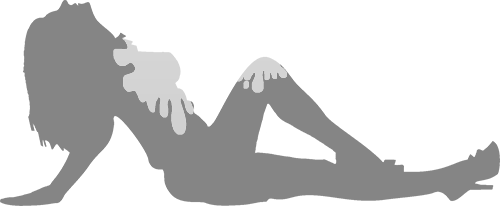
Design & Code ©1998-2025 Loverbuns, LLC 18 U.S.C. 2257 Record-Keeping Requirements Compliance Statement
Epoch Billing Support Log In





 Love you, too
Love you, too